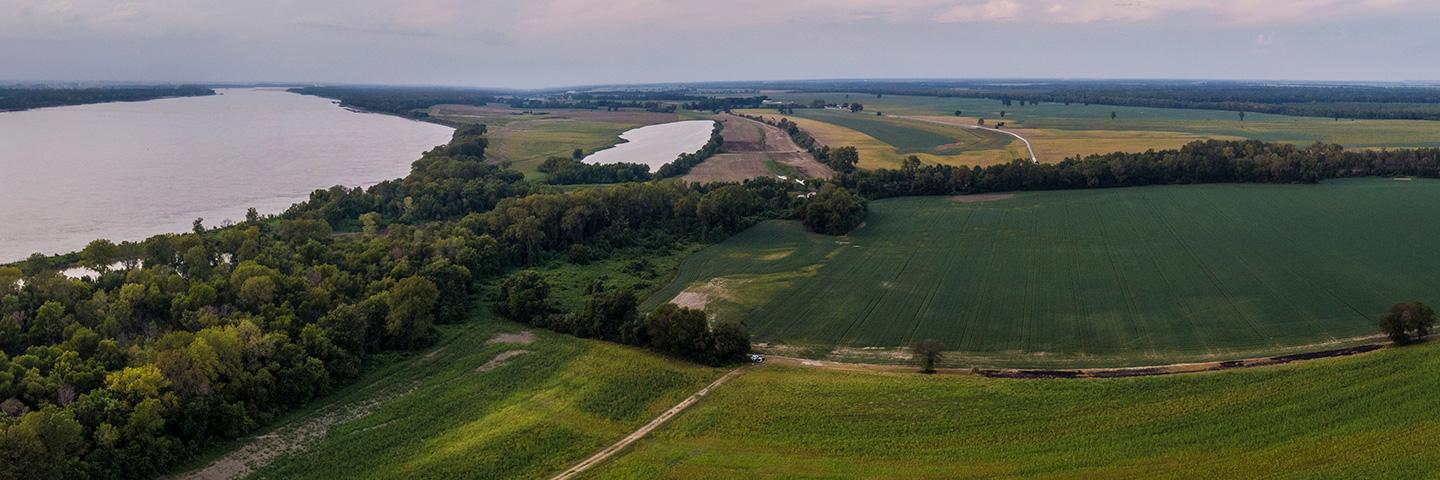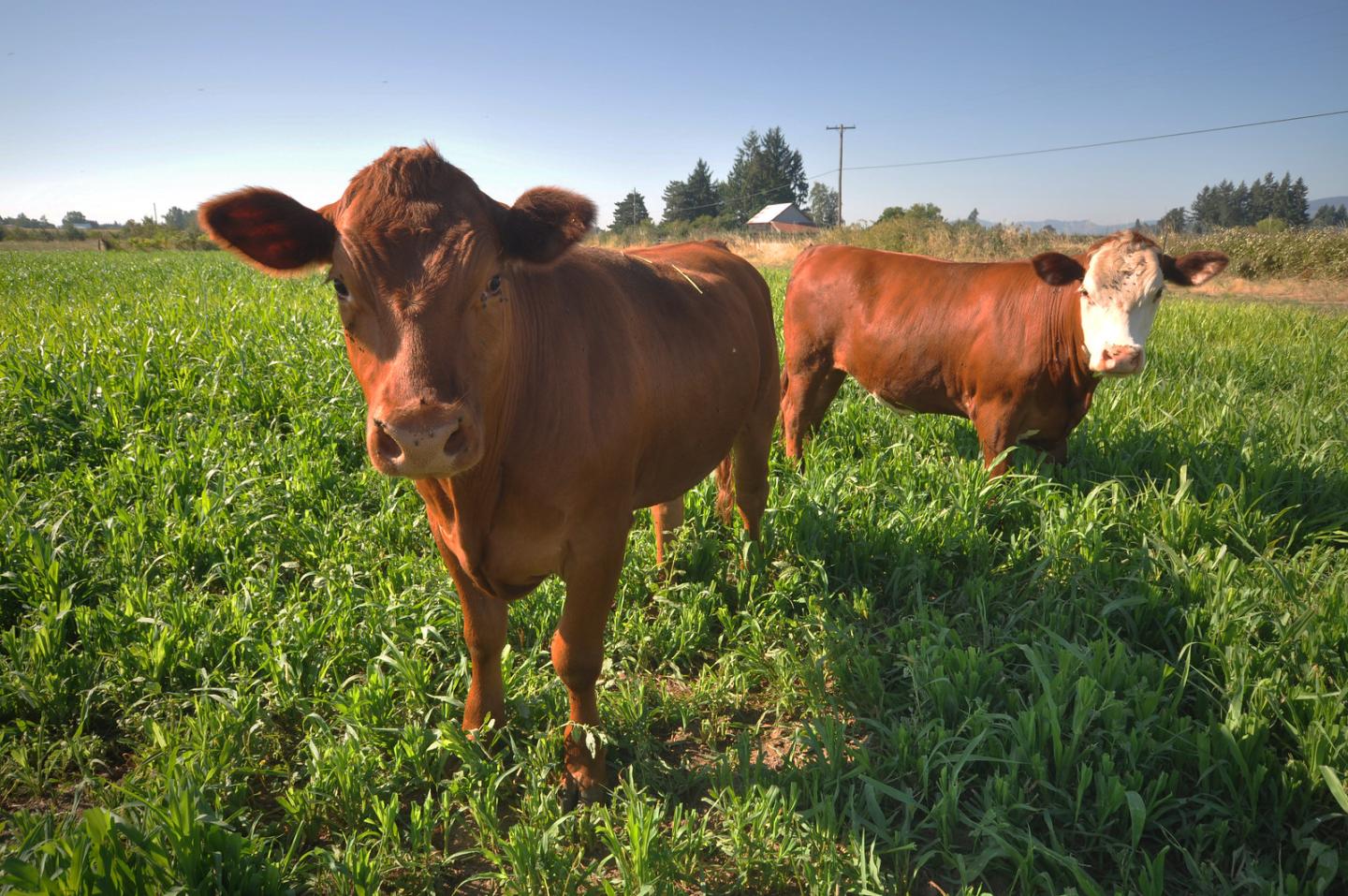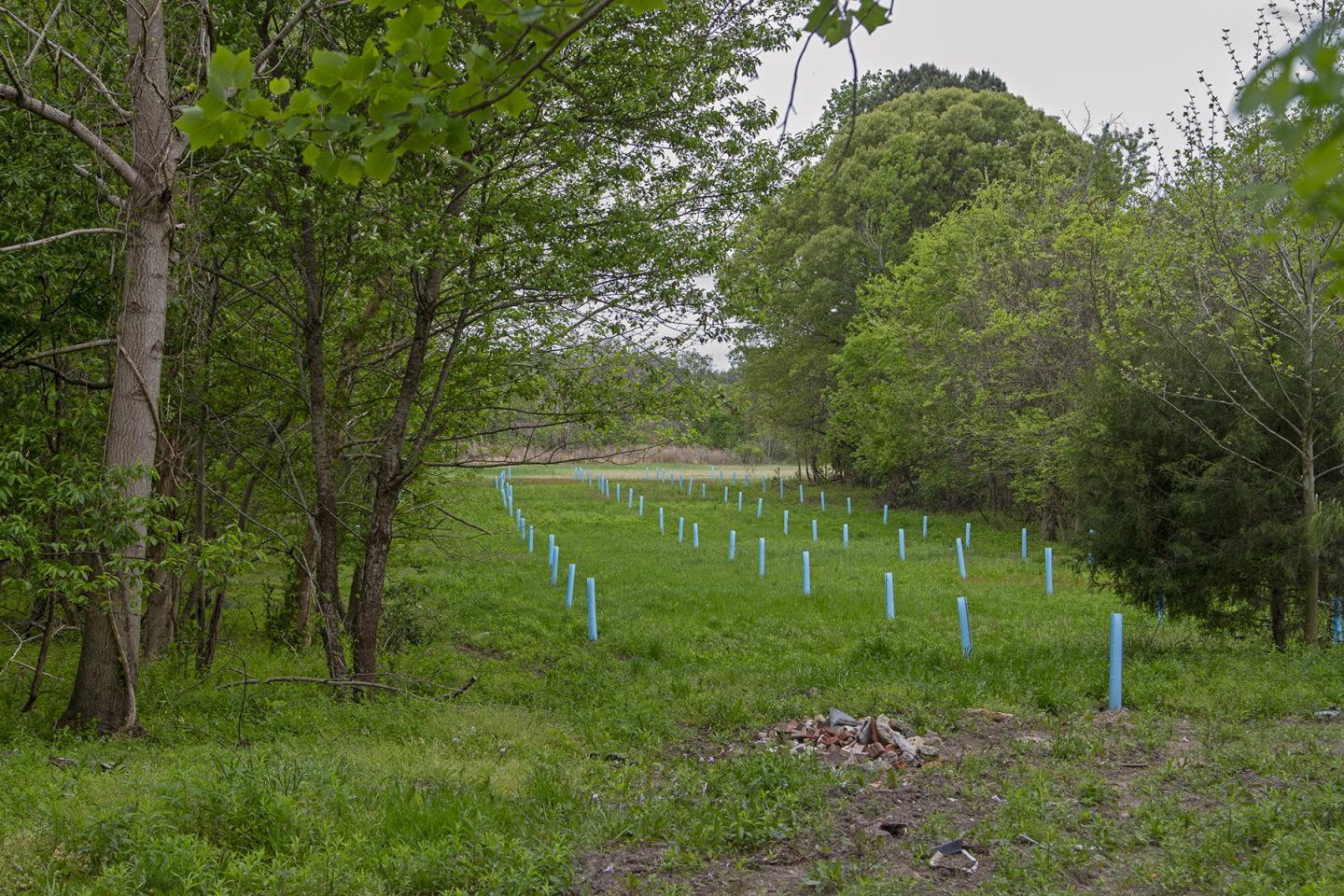
The Inflation Reduction Act represents the single largest investment in climate and clean energy solutions in American history.
Effective beginning 5/20/2025: Please note this site is under review and content may change.
Inflation Reduction Act assistance is available through NRCS’ oversubscribed conservation programs for agricultural producers. NRCS accepts producer applications for its conservation programs year-round, but for fiscal year 2024 funding, producers interested in the Environmental Quality Incentives Program or Conservation Stewardship Program should apply by their state’s ranking dates to be considered for funding in the current cycle.
Funding is provided through a competitive process and will include an opportunity to address the unmet demand from producers who have previously sought funding for climate-smart conservation activities. Those applications that were not previously funded, and those that are received after the ranking date, will automatically be considered during future funding cycles.
Fiscal Year 2024 and 2025 Data
For fiscal year 2024, NRCS released data showing it supported more than 23,000 climate-focused conservation contracts funded by the Inflation Reduction Act covering over 11 million acres, contributing to the highest total investment in private lands conservation in any year in NRCS history. The agency released final fiscal year 2024 state-by-state data showing where investments went from the Farm Bill and Inflation Reduction Act. See the December 4, 2024, news release.
For fiscal year 2025, NRCS is releasing data as it becomes available. See the latest fiscal year 2025 data in the tool.

Inflation Reduction Act Data Visualization Tool
State-by-state data showing investments by fiscal year for the Inflation Reduction Act and Farm Bill.
Inflation Reduction Act Investments
The Inflation Reduction Act provides an additional $19.5 billion over five years to support USDA’s conservation programs that yield climate change mitigation benefits. Implementation began in 2023. These investments mean that more producers will have access to conservation assistance and include:
- $8.45 billion for the Environmental Quality Incentives Program
- $4.95 billion for the Regional Conservation Partnership Program
- $3.25 billion for the Conservation Stewardship Program
- $1.4 billion for the Agricultural Conservation Easement Program
- $1 billion for Conservation Technical Assistance
- $300 million to measure, evaluate, quantify carbon sequestration and greenhouse gas emission reductions from conservation investments (see fact sheet)
For fiscal year 2025, which began Oct. 1, 2024, the Inflation Reduction Act provides:
- $2.8 billion for the Environmental Quality Incentives Program
- $1.4 billion for the Regional Conservation Partnership Program
- $943 million for the Conservation Stewardship Program
- $472 million for the Agricultural Conservation Easement Program
This is in addition to the $2 billion available for these programs through the Farm Bill, including $860 million for EQIP, $600 million for CSP, $450 million for ACEP, and $250 million for RCPP. These additional funds will help farmers and ranchers implement expanded conservation practices that reduce greenhouse gas emissions and increase storage of carbon in their soil and trees. The conservation funding is in addition to otherwise available program funds, and participation is voluntary, incentive-based and targeted to support climate-smart mitigation activities and other conservation activities that facilitate them.
NRCS Continues to Expand Inflation Reduction Act Opportunities
NRCS released an updated list of Climate-Smart Agriculture and Forestry Mitigation Activities eligible for Inflation Reduction Act funding in fiscal year 2025, which includes 14 new activities. NRCS also released the NRCS Conservation Practices and Greenhouse Gas Mitigation Information dashboard sharing the expected mitigation benefits and science-based estimation approach for listed practices.
These in-demand activities are expected to reduce greenhouse gas emissions or increase carbon sequestration, as well as provide significant other benefits to natural resources like soil health, water quality, pollinator and wildlife habitat and air quality. In response to feedback received from conservation partners, producers and NRCS staff across the country, NRCS considered and evaluated activities based on scientific literature demonstrating expected climate change mitigation benefits.
When applied appropriately, these activities are expected to reduce greenhouse gas emissions or increase carbon sequestration. NRCS will continue to evaluate additional practices based on available scientific literature and improve its estimation approaches.
To learn more, see the:
- Climate-Smart Agriculture and Forestry Mitigation Activities and Additional Planner Guidance
- NRCS Conservation Practices and Greenhouse Gas Mitigation Information dashboard
- Frequently Asked Questions
- The Role of Agriculture in Climate Change Mitigation
Agricultural Conservation Easement Program (ACEP)
Fiscal Year 2025 State-Led Funding Cycles
NRCS accepts applications year-round for ACEP Agricultural Land Easements (ACEP-ALE) and Wetland Reserve Easements (ACEP-WRE). Interested producers, landowners, and partners should apply by the next two ranking dates, Oct. 4, 2024, or Dec. 20, 2024, at their local NRCS office, to be considered for these two state-led funding cycles. In addition, any application submitted to NRCS that was unfunded in fiscal year 2024 will be automatically re-considered during the October 4 funding cycle.
In fiscal year 2025, states will receive Inflation Reduction Act funding and all eligible applications within a state will compete. The current ACEP priorities for the Inflation Reduction Act funding are unchanged from last fiscal year and are available in all states. Depending on location, NRCS may also have a state-specific priority. The Inflation Reduction Act funding is in addition to the funding authorized and available under the Farm Bill.
Project Selections
On March 13, 2024, NRCS announced it will invest about $138 million of financial assistance from the Inflation Reduction Act in 138 new climate-smart conservation easements, through which farmers and ranchers are conserving wetlands, grasslands and prime farmlands.
Expansion of priorities for the ACEP investments
NRCS expanded the national priority areas eligible for Inflation Reduction Act funding for ACEP easements in fiscal year 2024.
For ACEP Agricultural Land Easements (ALE), NRCS is currently prioritizing securing:
- Grasslands in areas of highest risk for conversion to non-grassland uses to prevent the release of soil carbon stores.
- Agricultural lands under threat of conversion to non-agricultural uses.
- State-specific priorities including rice cultivation on subsiding highly organic soils.
For ACEP Wetland Reserve Easements (WRE), NRCS is currently prioritizing:
- Land with soils high in organic carbon.
- Eligible lands that will be restored to and managed as forests like bottomland hardwood forests.
- Eligible lands in existing forest cover that will be managed as forests.
- Several geographically specific priorities (i.e., former cranberry bogs, wet meadows, and ephemeral wetlands in grassland ecosystems).
For more information, see our factsheet, The Agricultural Conservation Easements Program and the Inflation Reduction Act.
Building Capacity
Right now, we’re increasing staff to help implement the Inflation Reduction Act. NRCS plans to hire up to 4,000 new staff members as well as work with conservation partners to hire nearly 3,000 staff members to help producers develop conservation plans and implement conservation practices, including critical climate-smart practices. Go to USAjobs.gov and search for “NRCS” or “Natural Resources Conservation Service” to find the latest openings.
Streamlining Programs
To strengthen implementation of the Inflation Reduction Act, NRCS is improving its programs, including RCPP and ACEP.
For RCPP, NRCS has identified ways to streamline and simplify RCPP, ease the burden on employees and partners, and help maximize flexibility for partners to leverage their investments with NRCS resources and capabilities. Through a concerted effort since early 2023, using guidance, feedback and expertise from partners, employees, leadership and stakeholders, NRCS has identified several improvements that the agency will implement in the months and years ahead. Learn more about the RCPP improvement effort.
For ACEP, NRCS is updating its processes around appraisals, land surveys, as well as certifying eligible entities who help NRCS and producers enroll land into easements. These changes are for ACEP Agricultural Land Easements (ALE) as well as Wetland Reserve Easements (WRE). Learn more about ACEP improvements.
Greenhouse Gas (GHG) Quantification
To better understand and estimate the climate mitigation impacts of climate-smart conservation practices, the Inflation Reduction Act invests $300 million over eight years. The work supports USDA’s broader Measuring, Monitoring, Reporting and Verification (MMRV) efforts. See Greenhouse Gas Quantification and the Inflation Reduction Act.

Inflation Reduction Act in Action Interactive Map
See farmers, ranchers and forest landowners across the nation who are adopting climate-smart conservation practices with funding from the Inflation Reduction Act.
More Information
Blogs
Inflation Reduction Act in Action Blog Series:
- Helping Stabilize Agricultural Land in Southeastern Colorado (PDF Version)
- Utah Ranchers Utilize Cover Crops to Improve Soil Health (PDF Version)
- Kentucky Tree-Farming Family Fights Invasives and Aids Woodland Recovery (PDF Version)
- Family in Nebraska Restores and Protects Land at Risk Near Nine Mile Prairie (PDF Version)
- Houston Landowner Chooses Protection Versus Development (PDF Version)
- Alaska Native Producers See New Growth on Afognak Island (PDF Version)
- Funding Helps Wisconsin Producers Make Their Farm the Best it Can Be (PDF Version)
- NRCS Helps Family Farm Boldly Invest in Their Future (PDF Version)
- Energy Efficiencies Help Farmer Lower Costs While Protecting His Flock (PDF Version)
- Funding Drives Climate Change Mitigation and Resiliency on Maine Potato Farm (PDF Version)
- Small Farm Making Big Changes That Benefit Idaho Community (PDF Version)
- Funding Allows Montana Family Farm to Flourish through Climate-Smart Practices (PDF Version)
- A 21st Century Solution to Saving the Family Farm (PDF Version)
- Sovereign Nation Weaves Funding into Conservation Restoration (PDF Version)
- A Beginning Farmer’s Journey with Conservation (PDF Version)
- A Forester in Massachusetts Comes Back to His Roots (PDF Version)
- Protecting Family Land as Old as Minnesota (PDF Version)
- Texas/Oklahoma Rancher Turns Her Cropland Back to Grass (PDF Version)
- Bell Rock Livestock Association Partners with USDA to Keep Traditions Alive (PDF Version)
- Funding Makes Georgia Farmer’s Dream Come True (PDF Version)
- Sustainable Agriculture Drives Conservation Goals on Pennsylvania Farm (PDF Version)
Blog by the NRCS Chief:
Fact Sheets
- NRCS and the Inflation Reduction Act FY2024
- The Role of Agriculture in Climate Change Mitigation
- Accelerating Climate Solutions on Livestock Operations through the Inflation Reduction Act
- NRCS and the Inflation Reduction Act FY2023
- The Agricultural Conservation Easements Program and the Inflation Reduction Act
- Inflation Reduction Act Investments by State
- Harnessing the Inflation Reduction Act to Further Support:
- USDA Investment in Improved GHG Measurement, Monitoring, Reporting and Verification for Agriculture and Forestry through the Inflation Reduction Act
- NRCS Conservation Programs and the Inflation Reduction Act (IRA)
News Releases
- December 4, 2024: Biden-Harris Administration Sets Record Investment in Private Lands Conservation in 2024 Thanks to Inflation Reduction Act
- October 23, 2024: USDA Invests $1.5 Billion in 92 Partnership Projects to Advance Conservation and Climate-Smart Agriculture as Part of the Biden-Harris Investing in America Agenda
- October 2, 2024: Biden-Harris Administration Makes up to $7.7 Billion Available for Climate-Smart Practices on Agricultural Lands as Part of Investing in America Agenda
- July 12, 2024: USDA Announces Progress in Efforts to Improve Measurement, Monitoring, Reporting and Verification of Greenhouse Gas Emissions through President Biden’s Investing in America Agenda
- April 3, 2024: USDA Makes $1.5 Billion Available to Help Farmers Advance Conservation and Climate-Smart Agriculture as Part of President Biden’s Investing in America Agenda
- March 13, 2024: Agricultural Producers to Conserve Land through Climate-Smart Easements as part of President Biden’s Investing in America Agenda
- February 13, 2024: USDA Makes Record Investment in Private Lands Conservation
- February 5, 2024: USDA Celebrates 10 Years of Climate Hubs as Biden-Harris Administration Leads Historic Climate Agenda
- Sept. 28, 2023: Biden-Harris Administration Makes Available Historic $3 Billion for Climate-Smart Practices on Agricultural Lands Through Investing in America Agenda
- August 31, 2023: USDA Invests $65 Million for Conservation and Climate Action on Private Lands as Part of the Biden-Harris Administration’s Investing in America Agenda
- June 27, 2023: USDA Announces Historic Investment in Wildlife Conservation, Expands Partnership to Include Additional Programs
- June 23, 2023: USDA Hiring Engineers, Natural Resource Specialists Nationwide to Strengthen Inflation Reduction Act Implementation, Enhance Agricultural Conservation
- May 19, 2023: Biden-Harris Administration Announces Availability of $500 Million for Improved Regional Conservation Partnership Program to Better Support Partners, Producers as Part of Investing in America Agenda
- May 5, 2023: USDA Opens Full-Time, Entry-Level Soil Conservationist Positions across U.S. as Part of Broader Effort to Implement the Inflation Reduction Act
- February 13, 2023: Biden-Harris Administration Announces Availability of Inflation Reduction Act Funding for Climate-Smart Agriculture Nationwide
Data
FAQs
Webinars
Webpages
- Farmers.gov: Inflation Reduction Act Investments in USDA Programs

